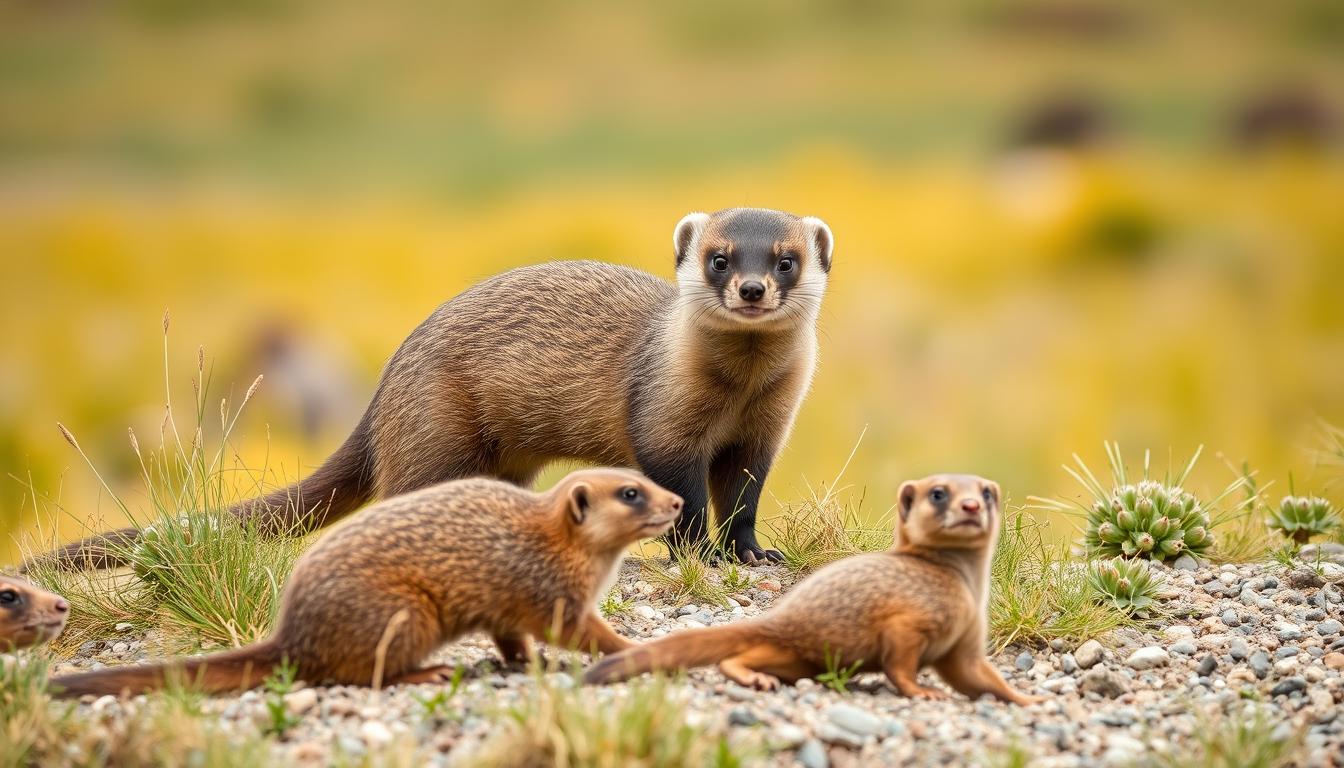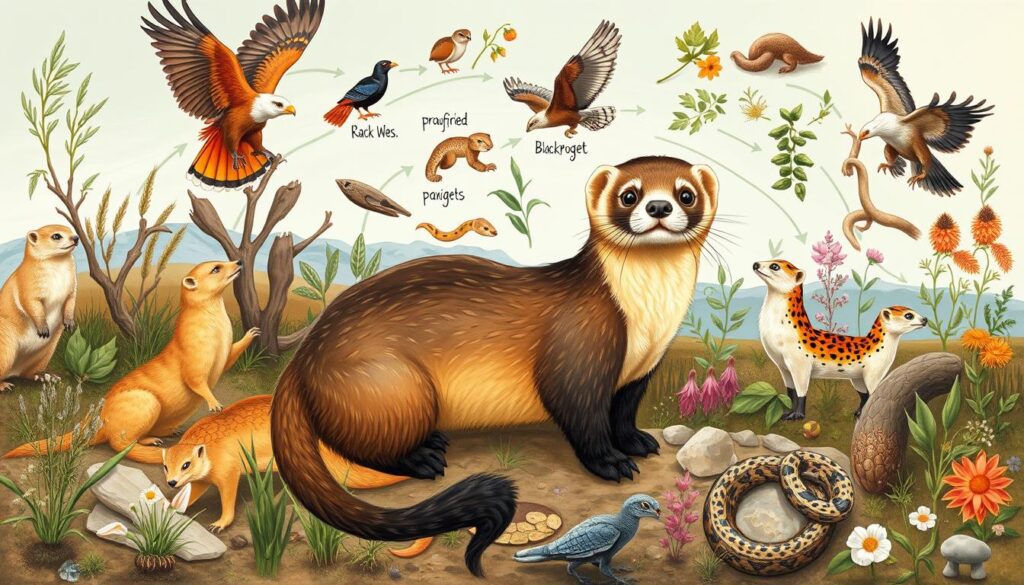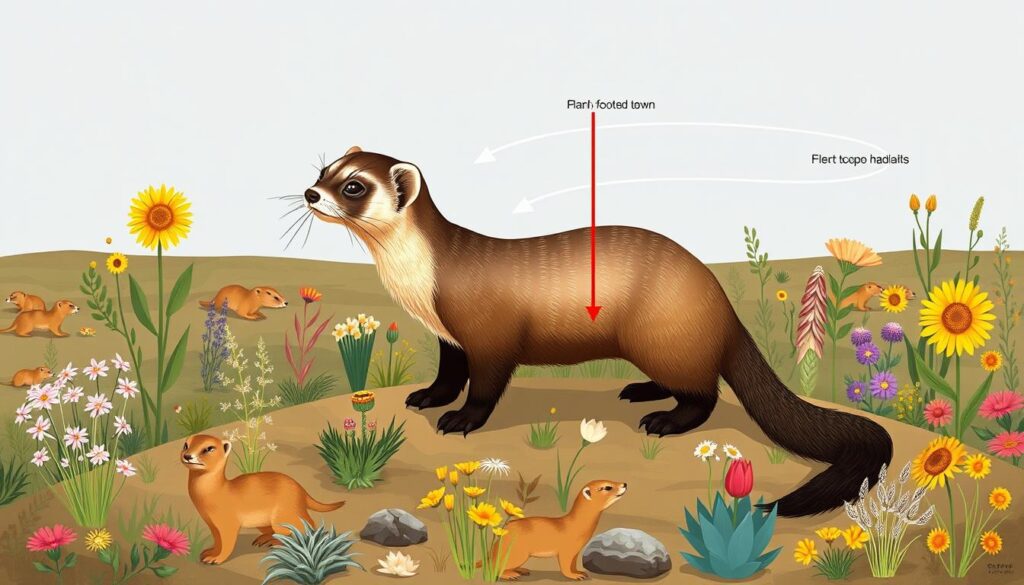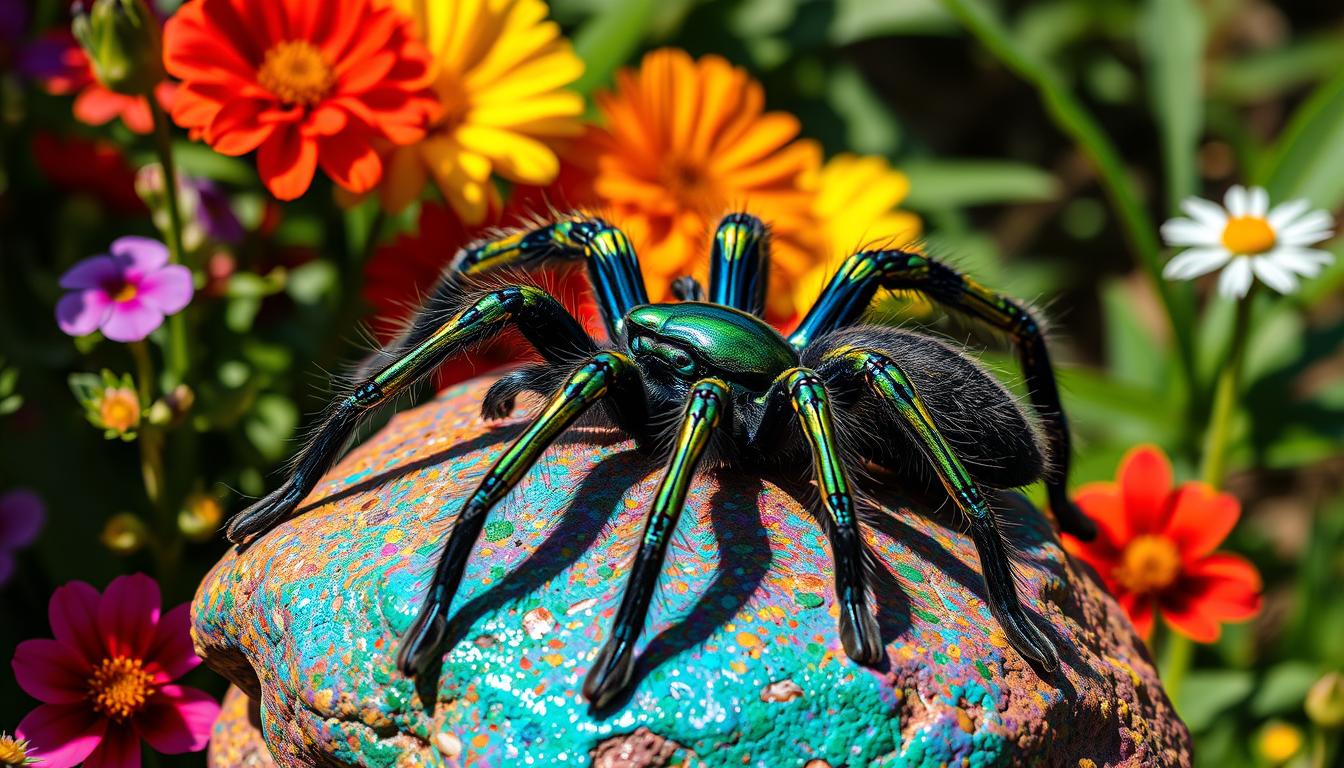Understanding the Black-footed Ferret’s Place in the Food Chain: Producer, Consumer, or Decomposer?

The black-footed ferret is a key player in the ecosystem. It mainly eats prairie dogs, making up 90% of its diet1. This shows how important prairie dogs are to the ferret’s survival. You can find more about the black-footed ferret’s role by visiting the black-footed ferret conservation page. It has lots of info on their habitat, behavior, and how to save them.
The black-footed ferret is a consumer in the food chain. It mainly eats prairie dogs, which are vital for its survival. The loss of prairie dogs has made black-footed ferrets endangered1. You can also check out the weasel animal pet page to learn about weasels and their role in nature.
Key Takeaways
- The black-footed ferret is a key species in the prairie ecosystem, playing a crucial role in maintaining the balance of the environment.
- Their diet consists mainly of prairie dogs, which are an essential part of their survival.
- The loss of habitat, particularly the decline of prairie dogs, has contributed to the endangered status of the black-footed ferrets1.
- Conservation efforts led by the US Fish and Wildlife Service have been instrumental in the recovery and potential full recovery of the black-footed ferret species1.
- The estimated number of black-footed ferrets currently living in the wild is 750, which is half of the population goal outlined in the 1988 Black-footed Ferret Recovery Plan2.
- The black-footed ferret’s ecological role is essential to the health of the environment, and their black footed ferret ecological role is critical to the balance of the prairie ecosystem.
Introduction to Black-footed Ferrets in Nature
Exploring black-footed ferrets reveals their unique physical characteristics. They have a yellowish-buff coat and black mask, key to their survival3. Found in North America’s grass prairies and hills, their habitat is crucial3. Despite their adaptability, their numbers have dwindled due to threats3.
Their black footed ferret population status is alarming, with only a few hundred left in the wild2. Yet, conservation efforts aim to safeguard these creatures and their habitats3. Understanding their physical traits and ecosystem role highlights the need to preserve them4.
For more on conservation and ecosystem preservation, visit petpawza.com. It offers insights into other animals and their habitats.
Physical Characteristics and Habitat
Black-footed ferrets stand out with their slender body and long tail2. They thrive in grasslands and prairies, burrowing in complex tunnels and dens3.
Historical Distribution in North America
Once widespread from Canada to Mexico, their numbers have ebbed and flowed3. Today, efforts focus on protecting these unique creatures and their habitats3.
Current Population Status
The current black footed ferret population status is dire, with only a few hundred remaining2. Yet, conservation efforts are in place to safeguard these animals and their habitats3.
| Category | Description |
|---|---|
| Physical Characteristics | Yellowish-buff coat, black mask, slender body, long tail2 |
| Habitat | Temperate grasslands, short or middle grass prairies, rolling hills3 |
| Population Status | Endangered, with only a few hundred individuals remaining in the wild2 |
Is a Black-footed Ferret Producer, Consumer, or Decomposer?
Exploring the black-footed ferret’s role in its ecosystem is key. They are consumers that eat prairie dogs, which are primary consumers5. This shows their place in the food chain. They help control the number of their prey, keeping the ecosystem balanced5.
Trophic levels are important for understanding energy flow in ecosystems. Producers, like plants, are at the base. Consumers, like the black-footed ferret, eat these producers or other consumers5. Decomposers break down dead matter, adding nutrients to the soil. The black-footed ferret’s role affects the whole ecosystem.
Here are some key points about the black-footed ferret’s role:
- The black-footed ferret is a secondary consumer, eating primary consumers like prairie dogs5.
- Its diet mainly consists of prairie dogs, a key species in its ecosystem5.
- The ferret’s trophic level is vital to its ecosystem, affecting its prey’s numbers5.
In conclusion, the black-footed ferret is a consumer crucial to its ecosystem. Its trophic level is key to its place in the food chain5. Understanding its role helps us value the complex relationships in its ecosystem and the need to protect it.
The Predatory Nature of Black-footed Ferrets
Black-footed ferrets are known for their black footed ferret predatory nature. This is key to their survival. They have black footed ferret hunting patterns that help them catch prey efficiently. This allows them to get energy from their prey through black footed ferret energy transfer. This energy is crucial for their growth and upkeep6.
Looking at their black footed ferret hunting patterns, it’s clear they are skilled hunters. They use their sharp teeth and strong jaws to kill small mammals7. The energy they get from their prey is vital for their survival. They have evolved to make the most of this energy transfer.
Some key aspects of the black footed ferret predatory nature include:
- Adaptation to their environment, allowing them to hunt effectively6.
- Specialized physical features, such as sharp teeth and strong jaws, which enable them to catch and kill prey7.
- A diet rich in small mammals, which provides the necessary energy for their survival through black footed ferret energy transfer.
Black-footed Ferrets as Secondary Consumers

As a black footed ferret secondary consumer, these animals are key in the ecosystem. They eat primary consumers like prairie dogs8. Their diet mainly consists of prairie dogs, which might limit their survival due to lack of food variety8. This unique relationship is a major part of the black footed ferret food web.
The energy lost as you move up the trophic level in a food chain is about 10%8. This shows how important the black-footed ferret’s role is in the food web, as a secondary consumer. Losing them could have big effects on other animals and plants in the ecosystem8.
Some key facts about the black-footed ferret’s role in the ecosystem include:
- Black-footed ferrets mainly live in temperate grasslands. Their diet is mostly prairie dogs, making up 90% of their food3.
- Prairie dog populations have dropped by 98% due to farming and hunting. This affects the food of black-footed ferrets3.
- Black-footed ferrets can live up to 3-4 years in the wild and up to 8-9 years in captivity3.
The black-footed ferret’s role as a secondary consumer is crucial for the ecosystem’s balance. As a black footed ferret secondary consumer, it helps control the population of primary consumers like prairie dogs. This affects the whole black footed ferret food web8.
Ecological Relationships with Prairie Dogs
The black footed ferret and prairie dog relationship is key to the grassland ecosystem. A single ferret eats many prairie dogs in one night9. This affects the prairie dog numbers, impacting the ferret’s home balance.
Black-footed ferrets need prairie dog burrows for shelter9. This bond is crucial for both species’ survival. Changes in prairie dog numbers can harm the ecosystem, affecting other predators too10.
Factors that shape the black footed ferret and prairie dog relationship include:
- Prairie dog population density
- Availability of food and shelter
- Predation pressure from other species
These elements are vital for the black footed ferret’s ecosystem. It’s important to protect prairie dog colonies for the ferret’s survival.
Conservation efforts should aim to balance prairie dog numbers and predators. This balance is crucial for the black-footed ferret’s survival9.
| Species | Role in Ecosystem |
|---|---|
| Black-footed Ferret | Predator |
| Prairie Dog | Prey |
| Swift Fox | Competitor |
Trophic Level Classification and Energy Flow

Exploring the ecosystem, you’ll see black-footed ferrets are key to balance. The black footed ferret trophic level classification shows their place in the food chain. They are tertiary consumers, mainly eating secondary consumers like prairie dogs3. This helps us understand the black footed ferret energy flow in their world.
The energy flow in ecosystems is complex. It moves energy from one level to another. For black-footed ferrets, their diet of prairie dogs3 affects their energy flow. The decline of prairie dogs is a big concern for their ecosystem11.
To grasp the trophic level and energy flow of black-footed ferrets, we must look at their ecosystem. Key factors include:
- Habitat loss and fragmentation11
- Over-harvesting and hunting11
- Climate change and its effect on food3
For more on ecosystems and conservation, check out this study guide. It dives deep into biodiversity and ecosystem balance.
Natural Predators and Survival Strategies
Black-footed ferrets face threats from coyotes, hawks, and owls3. They defend themselves with sharp teeth and strong jaws. They also use their sense of smell to detect danger3.
Adapting to their environment is a key survival strategy for black-footed ferrets. They are experts at hiding in small burrows, making it hard for predators to find them3. Being nocturnal means they are active at night, lowering their daytime predator risk.
Here are some key facts about black-footed ferret natural predators and survival strategies:
- Black-footed ferrets are preyed upon by coyotes, hawks, and owls3
- They use their sharp teeth and strong jaws to defend themselves3
- They have a keen sense of smell to detect danger3
- They are skilled at hiding and can fit into small burrows3
- They are nocturnal, reducing their chances of encountering predators during the day3
Understanding the black footed ferret natural predators and survival strategies is crucial for conservation. By studying their behavior and habitat, we can protect these amazing creatures and their habitats3.
| Predator | Defense Mechanism |
|---|---|
| Coyotes | Sharp teeth and strong jaws |
| Hawks | Keen sense of smell |
| Owls | Nocturnal behavior |
Role in Maintaining Prairie Biodiversity
The black footed ferret is a key player in the prairie ecosystem. It helps keep the ecosystem healthy and stable by maintaining prairie biodiversity12. By controlling prairie dog populations, it keeps the ecosystem balanced13.
This balance is crucial to prevent any one species from taking over. The black footed ferret’s role is vital for the ecosystem’s health13.
The ferret’s activities also support the ecosystem’s services. It helps control populations and cycles nutrients12. This benefits many other species in the prairie.
Its burrowing improves soil quality. This helps other species thrive in the prairie ecosystem13.
Some key services the black footed ferret provides include:
- Population control: It keeps prairie dog populations in check, preventing any one species from dominating13.
- Nutrient cycling: Its burrowing helps cycle nutrients, benefiting other prairie species12.
- Habitat creation: Its burrows provide homes for insects and small mammals13.
In summary, the black footed ferret is crucial for prairie biodiversity and ecosystem services. Its conservation is key to maintaining the prairie’s health and stability1213.
Impact on Grassland Communities
The black footed ferret is key in black footed ferret grassland communities. It affects the numbers of prairie dogs and other animals14. As a hunter, the ferret changes the balance of species in the grasslands14.
Prairie dogs, which are 91% of the ferret’s food, are crucial. Their decline affects the ferret population, showing how connected species are14.
Human actions, like building cities and using poison, harm prairie dogs14. Saving desert areas for ferrets is vital, as cities take over their homes14. Efforts to protect the ferrets, like in Colorado’s eastern prairie, are key15.
Some important facts about conservation are:
- About 1,000 wild black footed ferrets remain14.
- Prairie dog numbers have dropped, affecting ferrets14.
- Protecting aquatic life, butterflies, and plants is crucial15.
Conservation Status and Ecosystem Health
The black footed ferret’s conservation status is key to keeping the ecosystem balanced. Understanding their role in the ecosystem is crucial. Black footed ferrets are endangered due to habitat loss and fragmentation16. This shows the need for recovery programs and habitat restoration.
Recovery programs aim to protect the black footed ferret and its habitat. These include habitat restoration and species reintroduction. Organizations also educate the public on conservation and its impact on the ecosystem. Visit pet care resources for more information on animal conservation.
Improving black footed ferret ecosystem health involves several strategies:
- Habitat preservation and restoration
- Species reintroduction and monitoring
- Education and outreach programs
- Collaboration with conservation organizations
These actions help counter habitat loss and fragmentation. They aim to recover the black footed ferret population17.
Supporting conservation efforts helps protect the black footed ferret and its habitat. Every action counts, and together, we can make a big difference. Collective efforts can significantly improve the black footed ferret’s conservation status and ecosystem health16.
| Conservation Effort | Impact on Black Footed Ferret Ecosystem Health |
|---|---|
| Habitat Preservation | Reduces habitat loss and fragmentation, increasing available habitat for black footed ferrets |
| Species Reintroduction | Increases black footed ferret population, contributing to ecosystem balance and health |
Conclusion
As your journey through the fascinating world of black-footed ferrets comes to an end, it’s clear that these remarkable creatures play a vital role in maintaining the delicate balance of the prairie ecosystem. Serving as a key predator18, black-footed ferrets help regulate the populations of their primary prey, the prairie dog18, ensuring the overall health and diversity of the grassland communities18.
Through their intricate relationships with other species, black-footed ferrets contribute to the intricate web of life that sustains the prairie ecosystem. As secondary consumers, they play a crucial role in energy transfer, while their predatory behaviors help maintain the balance between prairie dog colonies and the surrounding vegetation18.
Recognizing the ecological significance of black-footed ferrets, conservation efforts are underway to protect and restore their populations. These initiatives are essential, as the survival of this species is inextricably linked to the well-being of the entire prairie biome18.
By safeguarding the black-footed ferret and its habitat, we not only preserve a unique and captivating species but also ensure the continued health and resilience of the prairie ecosystem as a whole18.
FAQ
What is the ecological role of the black-footed ferret?
Where do black-footed ferrets live and what are their physical characteristics?
Is a black-footed ferret a producer, consumer, or decomposer?
How do black-footed ferrets hunt and what is their prey?
What is the trophic level of black-footed ferrets?
How do black-footed ferrets interact with prairie dogs?
What is the trophic level classification of black-footed ferrets, and how does energy flow through the ecosystem?
What are the natural predators of black-footed ferrets, and how do they defend themselves?
How do black-footed ferrets contribute to maintaining prairie biodiversity?
What is the impact of black-footed ferrets on grassland communities?
What is the conservation status of black-footed ferrets, and how is their ecosystem health being addressed?
Source Links
- https://fcmod.org/blog/2020/05/10/daily-discovery-the-road-to-recovery-the-black-footed-ferret/ – Daily Discovery: The Road to Recovery – The Black-Footed Ferret – Fort Collins Museum of Discovery
- https://defenders.org/blog/2011/09/cant-live-without-em-black-footed-ferrets – Can’t Live Without ‘Em: Black-footed Ferrets
- https://www.torontozoo.com/pdfs/bff/teacher_activity_guide_full.pdf?a – PDF
- https://childofthecornx.livejournal.com/27363.html – BIOLOGY notes: Unit 5 Lesson 2: childofthecornx — LiveJournal
- https://www.fcgov.com/naturalareas/files/chapter-2-ecology.pdf – Chapter2 ecology.p65
- https://www.science.gov/topicpages/f/factors affecting predation – factors affecting predation: Topics by Science.gov
- https://www.science.gov/topicpages/r/removing top predators – removing top predators: Topics by Science.gov
- https://tigersciencealvarado.weebly.com/uploads/2/2/8/4/22845736/mountain_lion_foodweb_11b_12abcdf.pdf – Mountain Lion as Predator
- https://www.torontozoo.com/pdfs/bff/Teacher_Activity_Guide_pg13-49.pdf – PDF
- https://itempra.org/public/ls-8th-grade-misa-b-topic-v-life-science-s-set-v-prairie-ecosystem – 8th Grade MISA Topic “Life Science,” Set “Prairie Ecosystem” – Public Release
- https://www.cram.com/flashcards/bio-3-unit-5-study-guide-417137 – Bio 3 Unit 5 Study guide Flashcards
- https://aithor.com/essay-examples/tertiary-consumers-in-the-grassland-energy-pyramid – Tertiary Consumers in the Grassland Energy Pyramid
- https://www.translation-chinese.com.tw/aiseo/prairie-dog-food-web – prairie dog food web
- https://slideplayer.com/slide/4183118/ – The Black Footed Ferret – ppt video online download
- https://cnhp.colostate.edu/download/documents/2003/final_bastrategy_printcopy.pdf – Microsoft Word – final_bastrategy_printcopy.doc
- https://www.slideshare.net/slideshow/conservation-biology-33479188/33479188 – Conservation biology
- https://edit.jornada.nmsu.edu/catalogs/esd/078A/R078AY125TX – Ecological site R078AY125TX
- https://www.teacherspayteachers.com/browse/special-education/science?search=cause and effect chain – Cause and effect chain | TPT



